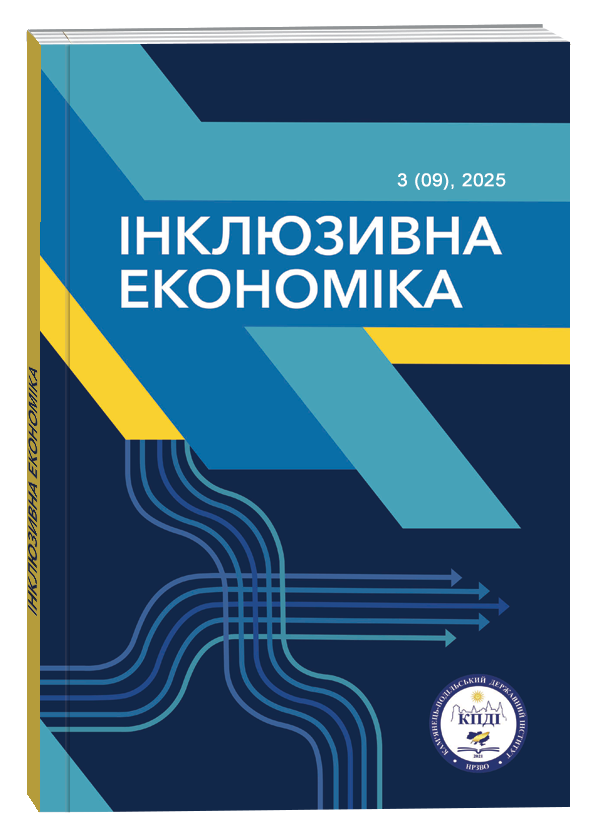CLASSIFICATION OF RISKS IN HEALTH INSURANCE: MEDICAL, SOCIAL, AND ACTUARIAL ASPECTS
DOI:
https://doi.org/10.32782/inclusive_economics.9-7Keywords:
medical insurance, risk, actuarial aspects, risk classification, insurance program, integrated riskAbstract
Introduction. The classification of risks in health insurance is a complex and critical undertaking, forming the foundation for the development of effective insurance programs. This process is rendered challenging by the inherent variability in medical conditions, the unique health profiles of individuals, rapid advancements in medical technologies, and the varying levels of access to healthcare services. These factors complicate the accurate prediction and assessment of potential insurance claims. Compounding this complexity is the current lack of a detailed and universally accepted classification of risks within the legislative framework of Ukraine. Purpose. This research aims to analyze the existing methods for classifying risks in health insurance from medical, social, and actuarial perspectives. It seeks to propose an integrated approach that allows for a more precise calculation of risks, thereby facilitating more effective management of insurance programs and better adaptation to the specific needs of insured individuals. The study underscores the interconnectedness of medical, social, and actuarial factors and emphasizes the need to consider these relationships in order to effectively manage risks in health insurance. Methods. The study employs a combination of literature review and analytical methods to assess various risk classification models in health insurance. Specifically, it includes the comparative analysis of existing scientific literature on risk classification in medical insurance, including works of Jonathan K. Weisberg, Thomas H. Kendall, and Nikolai D. Ostrom. Statistical and actuarial methods, including multiple regression and other predictive modeling techniques, are discussed for their potential use in the quantitative assessment of risks. Results. The analysis indicates that existing risk classification approaches often lack comprehensive consideration of the interplay between medical, social, and actuarial factors. The research identifies the need for a more holistic and integrated approach that incorporates these factors to improve risk assessment accuracy. Based on the findings, a formula for calculating the integral risk is proposed, which considers various medical, social, and actuarial indicators. Conclusion: The proposed classification of risks in health insurance from the medical, social, and actuarial point of view will provide the possibility to calculate the probability of the insurance case occuring and the expected costs. Therefore, integrating medical, social, and actuarial aspects is essential for effective risk management in health insurance.
References
Ніколаєнко С. М. Ризик-менеджмент у медичному страхуванні. Наукові праці МАУП. 2011. Вип. 3 (30), с. 141–144.
Шельпякова Т. В. Страхування як спосіб управління ризиками в сфері охорони здоров'я. Часопис Київського університету права. 2015. Вип. 2. С. 222-225.
Terje A. Risk assessment and risk management: Review of recent advances on their foundation. European journal of operational research. 2016. Vol. 253.1. P. 1-13.
Vose D. Risk analysis: a quantitative guide. John Wiley & Sons, 2008. 752 p.
Carper M.M., Heather B.M., Philip C. K.. Future directions for the examination of mediators of treatment outcomes in youth. Journal of Clinical Child & Adolescent Psychology. 2018. Vol. 47.2. P. 345-356.
Ojala B. A Cognitive-Behavioural Work-Related Program for Early Rehabilitation. Tampere: PunaMusta Oy, Yliopistopaino. Referred. 2019. Vol. 9.
Постанова НБУ № 182 від 25 грудня 2023 р. «Положення про характеристики та класифікаційні ознаки класів страхування, особливості здійснення діяльності зі страхування та укладання договорів за класами страхування». URL: https://zakon.rada.gov.ua/laws/show/v0182500-23#Text
Міжнародна статистична класифікація хвороб та споріднених проблем охорони здоров’я, 10-й перегляд (МКХ-10). URL: https://www.who.int/ru/news-room/spotlight/international-classification-of-diseases.
Amelung V.E.. Main Characteristics of the American Healthcare System. Healthcare Management: Managed Care Organisations and Instruments. Berlin, Heidelberg: Springer Berlin Heidelberg, 2019. P. 17-26.
Newhouse, Joseph P. Free for all?: lessons from the RAND health insurance experiment. Harvard University Press, 1993. 483 p.
Reinhardt, U. E. It's the incentives, stupid!: Comments on consumer-driven health care. Health Affairs. 2003. Vol. 22.6. P. 164-167.
Zweifel P. Energy, Insurance, and Health: Viewpoints of a Microeconomist. International Journal of the Economics of Business, 2018. Vol. 25.1. P. 191-204.
Nikolayenko S. M. (2011). Ryzyk-menedzhment u medychnomu strakhuvanni [Risk management in health insurance]. Naukovi pratsi MAUP, vol. 3(30), pp. 141–144.
Shelpyakova T. V. (2015). Strakhuvannya yak sposib upravlinnya ryzykamy v sferi okhorony zdorovya [Insurance as a way of risk management in health care]. Chasopys Kyivskoho universytetu prava, no. 2, pp. 222-225.
Aven T. (2016). Risk assessment and risk management: Review of recent advances on their foundation. European Journal of Operational Research, vol. 253(1), pp. 1-13.
Vose D. (2008). Risk analysis: a quantitative guide. John Wiley & Sons, 752 p.
Carper M. M., Makover H. B., Kendall P. C. (2018). Future directions for the examination of mediators of treatment outcomes in youth. Journal of Clinical Child & Adolescent Psychology, vol. 47(2), pp. 345-356.
Ojala B. (2019). A Cognitive-Behavioural Work-Related Program for Early Rehabilitation. Tampere: PunaMusta Oy, Yliopistopaino, vol. 9.
Postanova NBU № 182 vid 25 hrudnya 2023 r. «Polozhennya pro kharakterystyky ta klasyfikatsiyni oznaky klasiv strakhuvannya, osoblyvosti zdiysnennya diyal'nosti zi strakhuvannya ta ukladannya dohovoriv za klasamy strakhuvannya» [NBU Resolution No. 182 of December 25, 2023 "Regulations on the characteristics and classification features of insurance classes, features of insurance activities and conclusion of contracts by insurance classes"]. Available from: https://zakon.rada.gov.ua/laws/show/v0182500-23#Text.
World Health Organization. (1992). International statistical classification of diseases and related health problems (10th ed.). Available from: https://www.who.int/ru/news-room/spotlight/international-classification-of-diseases
Amelung V. E. (2019). Main characteristics of the American healthcare system. In Healthcare Management: Managed Care Organisations and Instruments. Springer, pp. 17-26.
Newhouse J. P. (1993). Free for all?: Lessons from the RAND health insurance experiment. Harvard University Press, 483 p.
Reinhardt U. E. (2003). It's the incentives, stupid!: Comments on consumer-driven health care. Health Affairs, vol. 22(6), pp. 164-167.
Zweifel P. (2018). Energy, Insurance, and Health: Viewpoints of a Microeconomist. International Journal of the Economics of Business, vol. 25(1), pp. 191-204.



